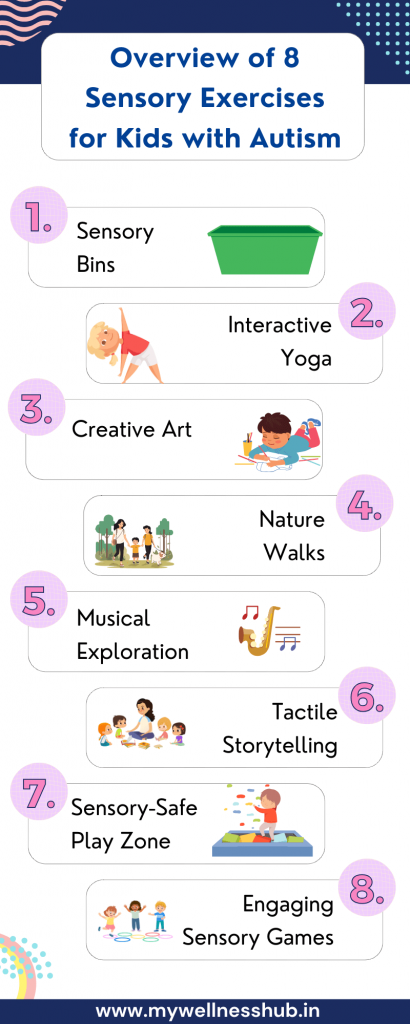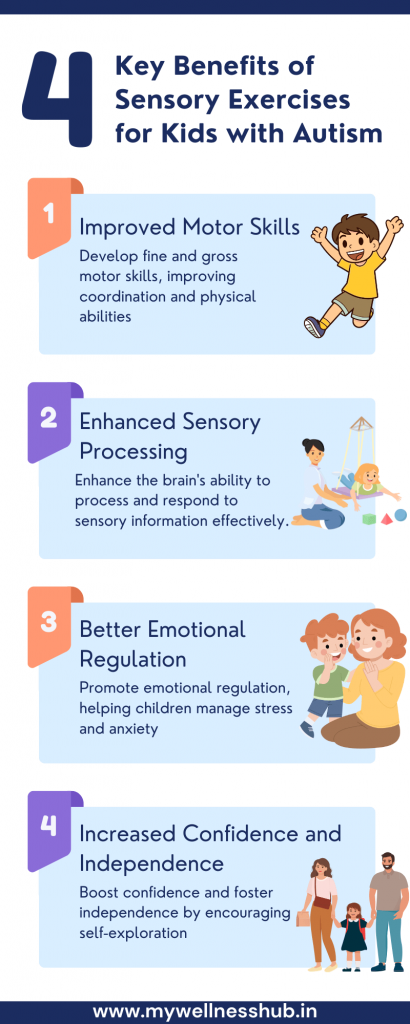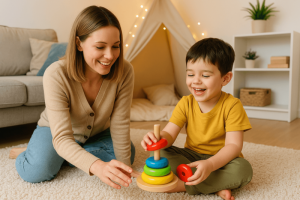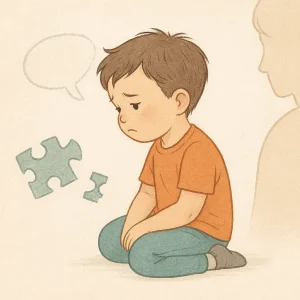8 Engaging Sensory Exercises for Kids with Autism
By Wellness Hub
Last Updated: May 18, 2024
Welcome to a journey of discovery and fun! If you’re parenting or caring for a child with autism, you know they experience the world differently, especially when it comes to processing sensory information. Sensory Exercises are not just about play; they’re crucial tools that help these wonderful children navigate their environments, making sense of what might be overwhelming or confusing.

Sensory Exercises for Kids
1. Sensory Bins: Explore and Learn
Sensory bins are a fantastic way to bring a world of textures to your child’s fingertips, offering an array of benefits for tactile and exploratory learning. Setting up a sensory bin is a simple and enjoyable activity that can be tailored to your child’s interests and needs, creating a personalized adventure right at home.
Creating Your Sensory Bin
Begin by choosing a container—a large plastic tub or even a shallow cardboard box can work well. Next, fill it with safe, non-toxic items that vary in texture and size. Common fillers include dry rice, beans, sand, or water beads. You can then add elements like small toys, colorful buttons, textured balls, or smooth stones. The goal is to provide a variety of sensory experiences that will engage and stimulate your child.
The Benefits of Sensory Bins
Sensory bins help children with autism improve their touch senses. Kids can dig, pour, scoop, and sift through different materials. This activity boosts their fine motor skills and hand-eye coordination. It also helps them learn to sort and recognize objects by size, shape, and texture. Sensory bins create a safe place for kids to explore and can be very helpful for those who may get overwhelmed by stronger sensory experiences.
Read more: Understanding and Improving Motor Skills in Autistic Children
2. Interactive Yoga Moves
Yoga can be a serene and strengthening practice for children with autism, helping them improve their body awareness and motor skills in a calming, engaging way. Simple yoga exercises designed for kids can become a joyful part of your child’s daily routine, offering benefits like better balance, flexibility, and stress relief.
Introducing Yoga to Your Child
Start with simple poses that are easy to do. Try poses like the tree, warrior, or butterfly. These are easy to copy and fun to watch. Show your child how to do the poses so they can follow along. Keep the session fun, and don’t worry about getting it perfect. Celebrate every try and focus on having a good time.
Finding Resources
There are many online resources and apps available that offer yoga routines tailored for children with autism. Platforms like Cosmic Kids Yoga provide engaging, story-led yoga adventures that captivate children’s imaginations while guiding them through movements. These resources are created with children’s abilities and interests in mind, ensuring that each session brings a new opportunity for physical and sensory growth.
Learn more: Navigating Parenting Challenges with Online Counselling
3. Creative Art and Texture Play
Art is a wonderful outlet for all children, especially those on the autism spectrum, allowing them to express themselves in ways beyond words. Incorporating textures into art activities not only spark creativity but also enhances sensory adaptation, making art a multifaceted therapeutic tool.
Engaging in Textured Art Projects
Start with finger painting using mixtures like sand or rice blended into paints. This adds a new sensory dimension to a familiar activity, encouraging your child to feel and see the differences as they paint. Crafting with varied materials such as fabric scraps, foam sheets, or feathers can also stimulate tactile senses and foster fine motor skills.
The Benefits of Creative Play
These activities promote creativity and can significantly improve your child’s ability to handle various textures, which might otherwise be challenging. The act of creating provides a sense of accomplishment and pride, boosting their confidence and willingness to engage in new sensory experiences.
4. Nature Exploration Walks
Getting outside and exploring nature can be a therapeutic experience for children with autism, providing a sensory-rich environment that stimulates learning and calm. Nature walks offer endless opportunities to engage with the world in a hands-on way, from the textures of different leaves to the sounds of chirping birds.
How to Make Nature Walks Educational and Calming
- Plan Your Route: Choose paths that are safe and not too crowded to minimize stress. Parks with varied landscapes (like water features, flower gardens, and wooded areas) can provide diverse sensory experiences.
- Engage the Senses: Encourage your child to touch different textures, listen to the sounds of nature, and smell the flowers and earth. You can bring along a small bag to collect safe items like leaves or stones for a sensory box at home.
- Use Visuals: Consider using a visual schedule or map to help your child understand what to expect on the walk. This can help reduce anxiety and make the experience more enjoyable.
5. Musical Exploration
Music can play a powerful role in the development of children with autism, affecting everything from emotional regulation to auditory processing. Simple musical activities can be set up at home to encourage these skills.
Enhancing Auditory Processing and Emotional Expression Through Music
- Create a Music Zone: Dedicate a small area in your home where your child can explore musical instruments. Include items like drums, xylophones, or homemade instruments (like shakers made from filled bottles).
- Interactive Play: Encourage your child to create sounds and rhythms. This can be a fun way to express emotions and interact with others, enhancing social skills through shared play.
- Routine Musical Activities: Incorporate music into daily routines to help transitions and structure, such as singing a song while getting dressed or cleaning up.
6. Tactile Storytelling
Storytime can be a multi-sensory experience that is great for children with autism. Using books with textured pages, scents, or sounds can make reading more engaging and fun.
How to Create a Multi-Sensory Storytelling Session
Choose the Right Books:
Look for books made for sensory exploration. Books with fabrics, scratch-and-sniff elements, or sound buttons are great choices. Examples include Pat the Bunny by Dorothy Kunhardt and The Very Hungry Caterpillar by Eric Carle, which has textured pages.
Engage Multiple Senses:
Encourage your child to touch the textured areas and talk about what they feel. If the book has scents or sounds, explore these together and discuss what you smell or hear.
Make It Interactive:
Ask questions about the story and sensory elements, like “How does the bunny feel?” or “What does this smell remind you of?” This helps your child stay engaged and develop their thinking and sensory skills.
7. Sensory-Safe Play Zone
Creating a sensory-safe play zone in your home can provide a tranquil retreat for your child to relax and manage sensory overload. This personalized space is essential for children who need a dedicated area to decompress and engage in gentle play.
Tips for Creating a Sensory-Friendly Area
- Use Calming Lights and Sounds: Soft, ambient lighting such as string lights or salt lamps can create a soothing environment. Gentle background music or nature sounds can also help calm the senses.
- Select Appropriate Toys: Include toys that are safe and sensory-based, such as soft plush toys, sensory mats, or fidget tools. Avoid items that are overly stimulating or noisy.
- Personalize the Space: Tailor the area to your child’s preferences. Some children might enjoy a small tent or canopy for a feeling of security, while others might prefer an open space with soft pillows.
8. Engaging Sensory Games
Games are a fantastic way to learn, and when it comes to sensory integration, they can be especially beneficial for children with autism. By engaging multiple senses, sensory games help children improve their cognitive, social, and physical skills in a setting that feels nothing but fun.
Sensory Bowling and Homemade Sensory Boards
- Sensory Bowling: This game involves touch, sight, and sometimes sound, making it an ideal multisensory activity. Use a soft foam ball and pins covered in different textured materials like fabric, sandpaper, or bubble wrap. As your child rolls the ball and knocks down the pins, they experience various textures and sounds, which can be incredibly stimulating and enjoyable.
- Homemade Sensory Boards: Create sensory boards using everyday objects like zippers, buttons, fabrics, and brushes. These boards can be touched, looked at, and manipulated, which helps children with autism understand and process different sensory inputs.
Educational Benefits of Sensory Games

Sensory games are more than just play; they’re crucial learning tools that teach children how to process and react to different sensory information. These games improve hand-eye coordination, develop problem-solving skills, and can significantly enhance communication abilities. By involving multiple senses, these activities encourage children to explore their environment, leading to better sensory integration.
Comparison of Sensory Exercises
| Exercises | Benefits | Required Materials | Ease of Setup | Description |
|---|---|---|---|---|
| Sensory Bins | Tactile skills, motor skills | Rice, beans, textured toys | Easy | Sensory bins involve filling a container with materials like rice or beans, adding textured toys to provide varied tactile experiences. These bins enhance tactile skills and fine motor coordination. |
| Interactive Yoga | Body awareness, motor skills | Yoga mat, online resources | Easy | Simple yoga exercises tailored for children with autism help improve body awareness and motor skills. Resources like videos or apps make it easy to follow along. |
| Creative Art | Creativity, sensory adaptation | Paint, textured materials | Moderate | Engaging in finger painting or crafting with various textured materials like sand, rice, or fabric fosters creativity and helps children adapt to different sensory inputs. |
| Nature Walks | Sensory processing, relaxation | Outdoor area | Easy | Nature walks provide sensory-rich experiences through different textures, sounds, and smells found in natural environments, promoting relaxation and sensory processing. |
| Musical Exploration | Auditory processing, emotional expression | Instruments, homemade sound items | Easy | Musical activities using simple instruments or homemade items enhance auditory processing and emotional expression, offering a fun way to explore sounds and rhythms. |
| Tactile Storytelling | Multi-sensory engagement | Sensory books | Easy | Reading books with textured pages or scents engages multiple senses, making storytelling an interactive and enriching experience for children with autism. |
| Sensory-Safe Play Zone | Emotional regulation, sensory breaks | Calming lights, soft music, sensory toys | Moderate | Creating a sensory-friendly area with calming lights, soft music, and safe toys provides a personalized space for emotional regulation and sensory breaks. |
| Sensory Games | Fun, cognitive, and physical skills | Foam ball, textured materials | Easy | Games like sensory bowling or using homemade sensory boards involve touch, sight, and sound, making learning fun and improving cognitive and physical skills. |
Conclusion
Incorporating sensory exercises into daily routines can greatly benefit children with autism. Activities like sensory bins, yoga, nature walks, and sensory-safe play zones provide important opportunities for touch, sound, and visual stimulation. These fun and engaging sensory exercises help children improve their sensory processing skills, motor coordination, and emotional regulation.
Remember, every child with autism is unique, so it’s important to adapt these activities to fit your child’s needs and preferences. By observing their responses and adjusting the activities accordingly, you can make the exercises more effective and ensure your child feels understood and supported. For more resources and expert guidance, visit Wellness Hub’s therapy resources page. Making sensory exercises a regular part of your child’s life can help them navigate their world with more confidence and joy.
Frequently Asked Questions:
1. What are sensory exercises for autism?
Sensory exercises for autism are activities designed to help children with autism improve their ability to process and respond to sensory information. These activities can involve touch, sound, sight, and movement, and they help enhance sensory processing skills, motor coordination, and emotional regulation.
2. How do sensory bins help children with autism?
Sensory bins help children with autism by providing a variety of tactile experiences. These bins are filled with materials like rice, beans, and textured toys that children can explore. This exploration helps improve their fine motor skills, hand-eye coordination, and sensory processing abilities.
3. What are some simple yoga exercises for children with autism?
Simple yoga exercises for children with autism include poses like the tree, warrior, and butterfly. These poses are easy to follow and can help improve body awareness, balance, and motor skills. Online resources and apps like Cosmic Kids Yoga offer child-friendly yoga routines.
4. How can nature walks benefit children with autism?
Nature walks can benefit children with autism by providing a calming and sensory-rich environment. Experiencing different textures, sounds, and smells in nature helps children improve their sensory processing skills and can be both relaxing and educational.
5. What are some creative art activities for children with autism?
Creative art activities for children with autism include finger painting with textured materials like sand or rice and crafting with various fabrics and foam sheets. These activities foster creativity and help children adapt to different sensory experiences.
6. How can music therapy help children with autism?
Music therapy can help children with autism by enhancing auditory processing and emotional expression. Simple musical activities, like playing instruments or making homemade sound items, can be incorporated into daily routines to support sensory development.
7. What is tactile storytelling, and how can it help children with autism?
Tactile storytelling involves using books with sensory elements like textured pages and scents. This type of storytelling engages multiple senses and helps children with autism better understand and enjoy the story. Examples of suitable books include Pat the Bunny and The Very Hungry Caterpillar.
8. How can I create a sensory-safe play zone at home?
To create a sensory-safe play zone at home, use calming lights, soft music, and safe sensory toys. This personalized space provides a tranquil retreat where children can relax and manage sensory overload, essential for their emotional and sensory development.
9. What are some engaging sensory games for children with autism?
Engaging sensory games for children with autism include sensory bowling with textured pins and homemade sensory boards with everyday objects like zippers and buttons. These games are fun and educational, helping improve cognitive, social, and physical skills.
10. Where can I find more resources on sensory exercises for children with autism?
For more resources on sensory exercises for children with autism, visit Wellness Hub’s therapy resources page. Here, you can find expert advice and tailored therapies designed to meet the unique needs of each child.
About the Author:
Anuradha Karanam
Speech-language pathologist (7+ years of experience)
Anuradha Karanam is a skilled speech-language pathologist with over 6 years of experience. Fluent in Tamil, Telugu, Hindi, and English, she specializes in parent counseling, speech sound disorders, fluency assessment, and speech-language evaluations. Anuradha excels at working with children with developmental disorders, offering creative and effective therapy programs. Currently at Wellness Hub, she holds a BASLP degree and is registered with the RCI (CRR No A85500). Her patience, ambition, and dedication make her a trusted expert in her field.
Connect with Anuradha to learn more about how she can help you or your loved one find their voice.
Book your Free Consultation Today
Parent/Caregiver Info:
Client’s Details:
* Error Message








